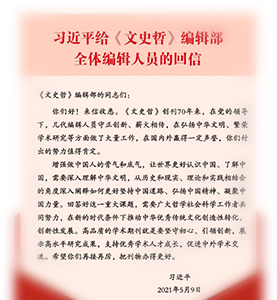从甲骨文“呙”字说到殷人的忧患观念 晁福林
甲骨文“ ”,当释为“呙”,在卜辞中多读为“祸”,过去将甲骨文“
”,当释为“呙”,在卜辞中多读为“祸”,过去将甲骨文“ ”字释读为“祸”,实为鸠占鹊巢。“
”字释读为“祸”,实为鸠占鹊巢。“ ”当依于省吾先生说读为“咎”。它与甲骨文“祸”字虽然同与灾害有关,却有不少区别。主要是在卜辞里,祸由人起,而咎自外来。殷人的灾患观念里既有对神灵的迷信,又有一定的反省精神和深深的忧患意识,还有一些勇于担责的气魄。战国时期,孟子论国家存亡之机曾有“生于忧患而死于安乐”的著名论断。商王朝立国五百余年,与殷人浓厚的忧患意识是有关系的。
”当依于省吾先生说读为“咎”。它与甲骨文“祸”字虽然同与灾害有关,却有不少区别。主要是在卜辞里,祸由人起,而咎自外来。殷人的灾患观念里既有对神灵的迷信,又有一定的反省精神和深深的忧患意识,还有一些勇于担责的气魄。战国时期,孟子论国家存亡之机曾有“生于忧患而死于安乐”的著名论断。商王朝立国五百余年,与殷人浓厚的忧患意识是有关系的。
A Discussion of the Suffering Consciousness of the Yin People
from the Character “ ” in Oracle bone Inscription
” in Oracle bone Inscription
Chao Fulin
In most cases, the character “ ” should be interpreted as huo (disaster) in oracle inscriptions, and another character “
” should be interpreted as huo (disaster) in oracle inscriptions, and another character “ ”should be interpreted as jiu (blame) according Yu Xingwu’s statement. In oracle inscriptions, disasters were principally cause by people, while blame came from the outside. There were superstitions in gods, certain introspection, deep suffering consciousness, as well as courage to act coexisting in the ideas of Yin people. In the Warring States period, Mencius once posed the famous judgment that “life springs from sorrow and calamity, and death from ease and pleasure.” The Shang Dynasty lasted for more than five centuries, which had much to do with their suffering consciousness.
”should be interpreted as jiu (blame) according Yu Xingwu’s statement. In oracle inscriptions, disasters were principally cause by people, while blame came from the outside. There were superstitions in gods, certain introspection, deep suffering consciousness, as well as courage to act coexisting in the ideas of Yin people. In the Warring States period, Mencius once posed the famous judgment that “life springs from sorrow and calamity, and death from ease and pleasure.” The Shang Dynasty lasted for more than five centuries, which had much to do with their suffering consciousness.


